
Syllabized IGCSE Biology
🌷
before you read🌷core content is written like this
supplement content is written like this
non-syllabus content is written like this
stuff you shouldn’t write in your exam is written like this
words you have to define are written like this
credit to taleen
1 - Characteristics and classification of living organisms
1.1 Characteristics of living organisms
1 - Define the seven life processes, MRS GREN:
Movement - An action by an organism of part of an organism that causes a change in position or place
Respiration - The chemical reactions in cells that break down nutrient molecules and release energy for metabolism
Sensitivity - The ability to detect and respond to changes in the internal or external environment
Growth - A permanent increase in size and dry mass
Reproduction - The processes that make more of the same kind of organism
Excretion - The removal of the waste products of metabolism and substances in excess of requirements
Nutrition - The taking in of materials for energy, growth and development
1.2 Concept and uses of classification systems
Organisms can be classified into groups by the features that they share, with what we call a classification system.
Classification systems aim to reflect evolutionary relationships, showing the similarities in organisms as they evolved and grouping them into classes.
A species is a group of organisms that can reproduce to produce fertile offspring.
The binomial system is a system we use to name species. It is internationally agreed and consists of two parts, the genus and the species.
The genus comes first and has a capital first letter, while the species comes after and is in full lowercase. We also usually write it in italics. An example is Bombyx mori (“Bombyx” is the genus while “mori” is the species).
Scientists used to just classify organisms based on the features they share but this sometimes got problematic. We now more often use the sequences of bases in DNA as a means of classification.
Groups of organisms which share a more recent ancestor (are more closely related) have more similar base sequences in DNA.
This method of classification is the most efficient way of classifying organisms, with the others being morphology and anatomy.
Dichotomous keys
A dichotomous key classifies and identifies organisms with a sequence of questions about their features. Here’s an example of one.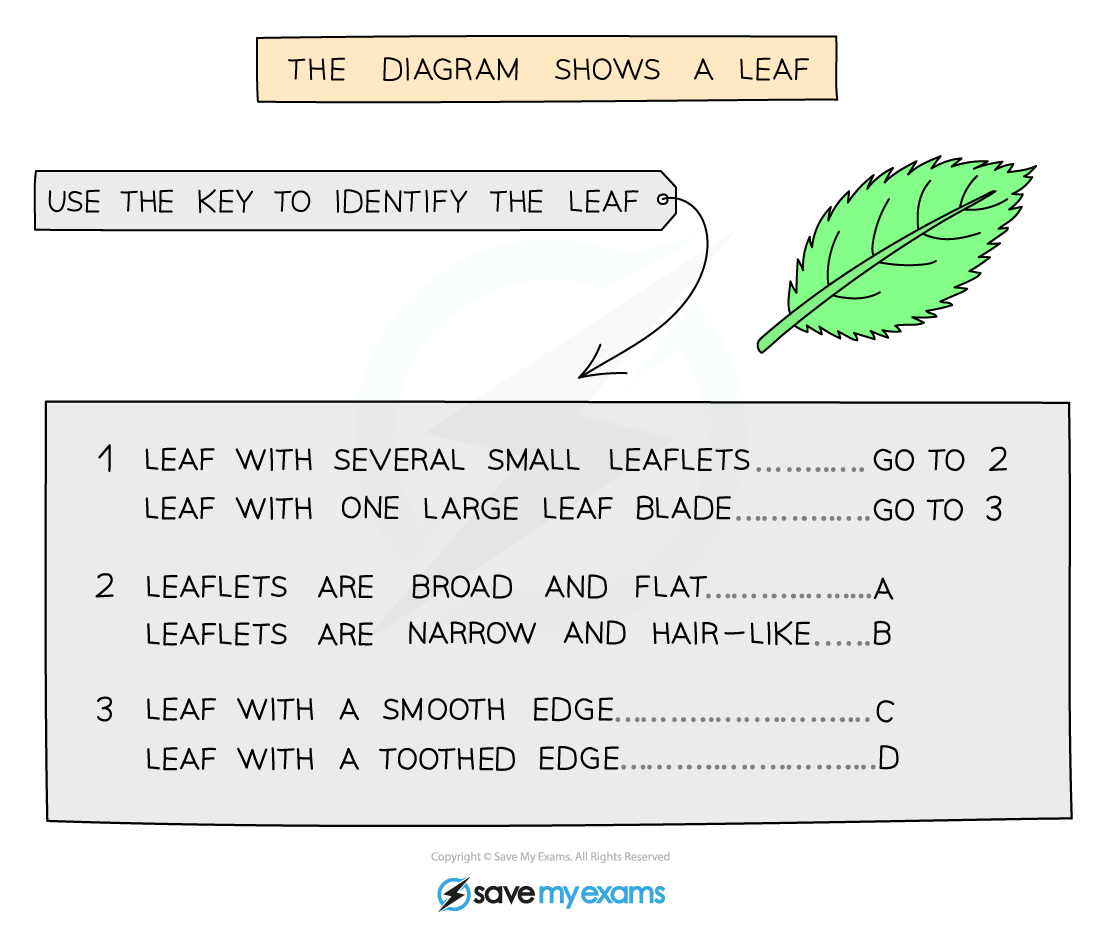
1.3 Features of organisms
You must be able to classify organisms based on the characteristics you’re about to see (the ones in the tables).
There are five kingdoms:
Animals
Plants
Fungi
Protoctists
Prokaryotes
KINGDOM | Plants | Animals | Fungi | Protoctists | Prokaryotes |
CELL COUNT | Multicellular | Multicellular | Usually multicellular | Usually unicellular | Usually unicellular |
CELL FEATURES | - nuclei - chloroplasts - cell walls (which are made of cellulose) | - nuclei - no chloroplasts - no cell walls | - nuclei - no chloroplasts - cells walls (not made of cellulose) | - nuclei - some have cell walls - some have chloroplasts | - cell walls (not of cellulose) - cytoplasm - no nuclei - no mitochondria |
The animal kingdom
It has two groups:
Vertebrates, they have a backbone
Invertebrates, they have no backbone
Here are the main groups of vertebrates:
VERTEBRATE GROUP | Mammals | Birds | Reptiles | Amphibians | Fish |
FEATURES | Fur/hair on skin, have a placenta, young feed on milk from mammary glands, external ears (pinna) visible, endothermic | Skin covered in feathers, have 2 legs and 2 wings, lay eggs with hard shells on land, have a break, endothermic | Dry scales on skin, lay eggs with rubbery shells on land | Smooth, moist skin, adults usually live on land (have lungs), larvae live in water (have gills) lay eggs without shells in water | Loose wet scales on skin, gills to breathe, lay eggs without shells in water |
We classify invertebrates into the phylum Arthropods if they have jointed legs.
Here are the main groups of arthropods:
ARTHROPOD GROUP | Insects | Arachnids | Crustaceans | Myriapods |
FEATURES | 3 part body (head, thorax, abdomen), 3 pairs of jointed legs, 2 pairs of wings, 1 pair of antennae | 2 part body (cephalothorax, abdomen), 4 pairs of jointed legs, no antennae | More than 4 pairs of jointed legs, chalky exoskeleton, breath through gills, 2 pairs of antennae | Body consists of many segments, each segment contains at least 1 pair of jointed legs, 1 pair of antennae |
The plant kingdom
It has two main groups:
Ferns:
Have leaves called fronds
Reproduce by spores produced on the underside of fronds
Flowering plants:
Reproduce by sexual reproduction
Are divided into two groups - monocotyledons and dicotyledons
Monocotyledons | Dicotyledons |
Flower petals in multiples of 3 | Flower petals in multiples of 4 or 5 |
Parallel leaf veins | Branched/reticulated leaf veins |
Viruses
Viruses are not considered living things as they do not carry out the 7 life processes.
Their structure consists of genetic material (like DNA or RNA) inside a protein coat.
2 - Organization of the organism
2.1 Cell structure
The table below compares the features of animal cells, plant cells and bacterial cells:
Animal cell | Plant cell | Bacterial cell |
No cell wall | Cellulose cell wall | Cell wall not made of cellulose |
Have a cell membrane | Have a cell membrane | Have a cell membrane |
Have a nucleus | Have a nucleus | No nucleus |
Have a cytoplasm | Have a cytoplasm | Have a cytoplasm |
Have ribosomes | Have ribosomes | Have ribosomes |
Have mitochondria | Have mitochondria | No mitochondria |
No chloroplasts | Have chloroplasts | No chloroplasts |
No vacuoles | Have vacuoles | No vacuoles |
Non-circular DNA | Non-circular DNA | Circular DNA |
No plasmids | No plasmids | Have plasmids |
The diagrams shown below portray animal cells, plant cells and bacterial cells respectively: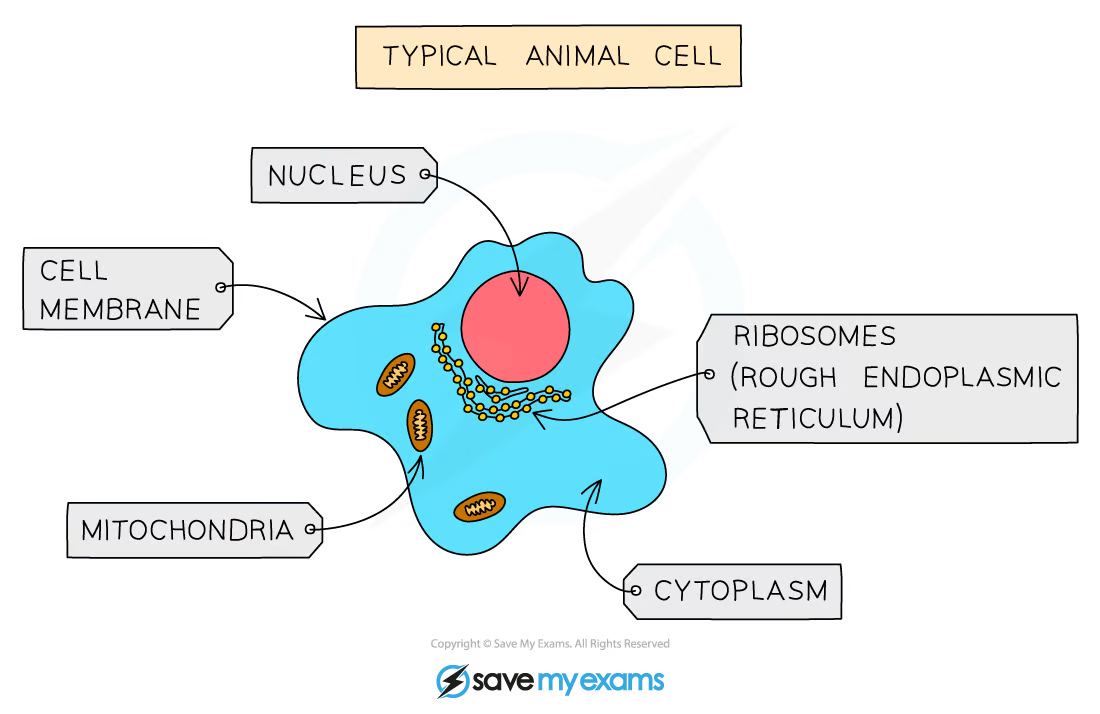
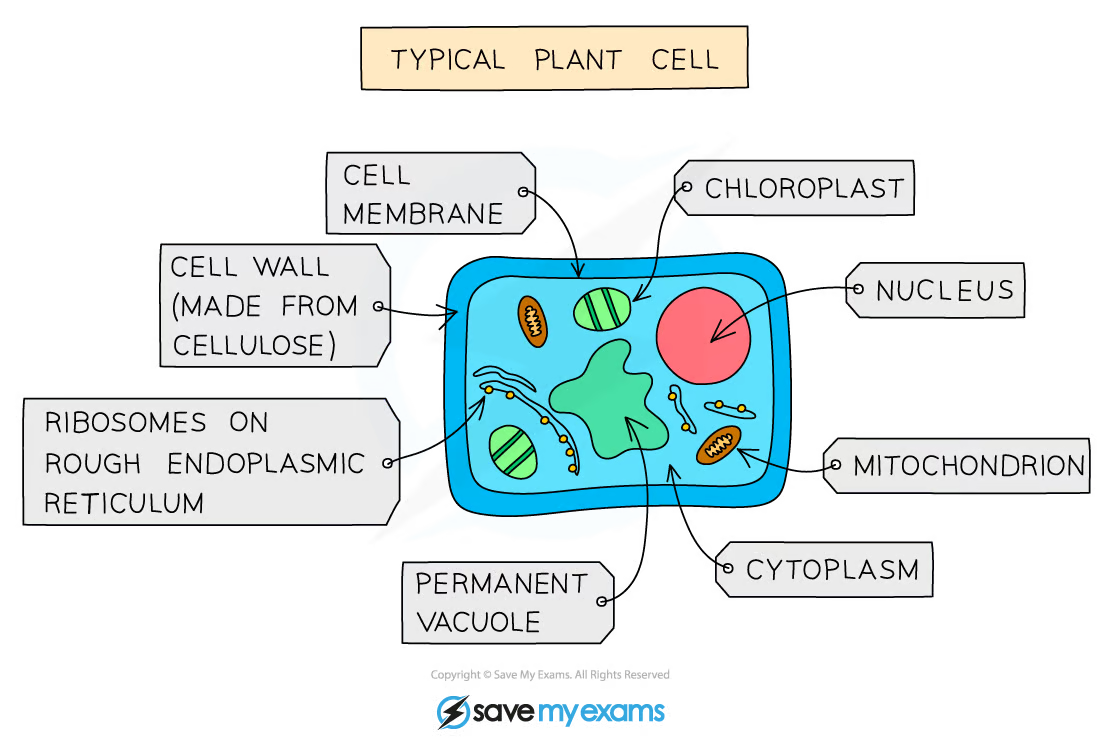
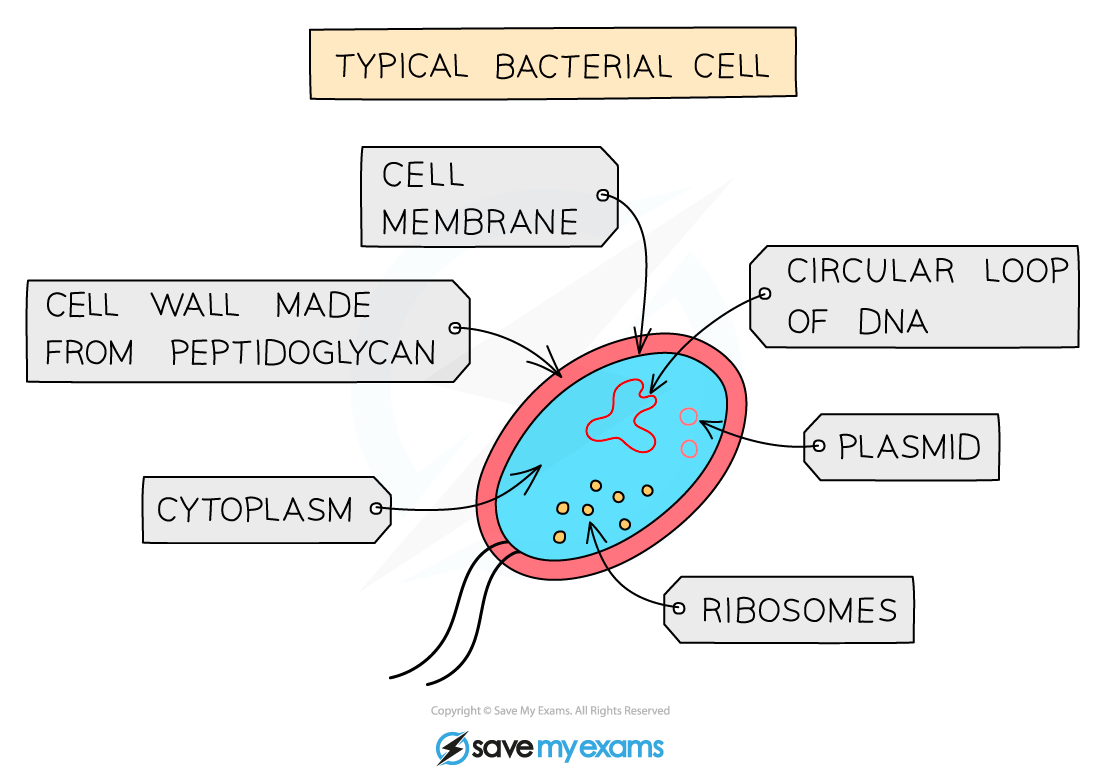 You must know how to describe the functions of the parts shown as well:
You must know how to describe the functions of the parts shown as well:
Cell membrane - holds the cell together, controls the substances which can enter and leave the cell
Nucleus - contains the genetic material which controls the activities of the cell
Cytoplasm - gel-like substance composed mostly of water, supporting the internal cell structures and is the site of the chemical reactions in the cell
Ribosome - the site of protein synthesis
Mitochondria (singular: mitochondrion) - site of aerobic respiration, releases energy. (yes, it is the powerhouse of the cell)
Cell wall - gives the cell extra support, defining its shape
Chloroplast - contains green chlorophyll pigments and it is the site of photosynthesis
Vacuole - stores cell sap, it’s made up of water, sugar and salts. It’s also used for storage of other materials, and supports the shape of the cell
Circular DNA - circular chromosome of DNA that replaces nucleus in bacterial cells
Plasmid - small circular loops of DNA that contain extra genes to those found in chromosomal DNA
New cells are produced by division of existing cells.
Specialized cells have specific functions, including:
Cell | Function |
|---|---|
Ciliated cells | Movement of mucus in the trachea and bronchi |
Root hair cells | Absorption |
Palisade mesophyll cells | Photosynthesis |
Neurons | Conduction of electrical impulses |
Red blood cells | Transport of oxygen |
Sperm and egg cells (gametes) | Reproduction |
Define the levels of organization in organisms:
Cells - basic structural and functional units in an organism
Tissues - groups of cells of similar structure working together to perform the same function
Organs - made from different tissues working together to perform different functions
Organ systems - groups of organs with related functions working together to perform body functions
Organism - a living thing.
In size, from smallest to largest:
cell → tissue → organ → organ system → organism
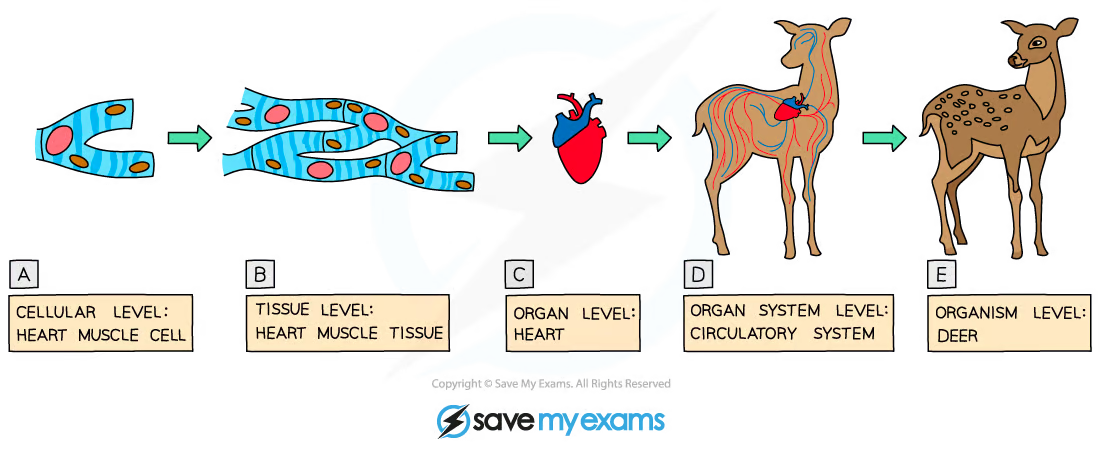 2.2 Size of specimens
2.2 Size of specimens
Magnification (M) = image size (I) ÷ actual size (A)
We can use an equation triangle to remember this formula:
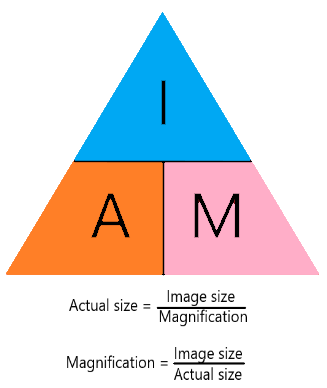 We don’t use units for magnification, it is written as, for example, “x70”, “x100” or “x69”
We don’t use units for magnification, it is written as, for example, “x70”, “x100” or “x69”
If asked to measure a diagram, it will usually be in millimeters.
You must be able to convert between millimeters and micrometers.
1mm = 1000μm (micrometers)
So you multiply millimeter values by 1000 to get a micrometer value and you divide micrometer values by 1000 to get a millimeter value.
3 - Movement into and out of cells
3.1 Diffusion
Diffusion is the net movement of particles from a region of higher concentration to a region of lower concentration down the concentration gradient (as a result of their random movement).
Energy for diffusion comes from the kinetic energy of random movement of molecules and ions.
Some substances move into and out of cells by diffusion through the cell membrane.
Diffusion happens everywhere, including:
Organisms carrying out gas exchange for respiration
Water vapor diffusing out of a leaf’s stomata
Food diffusing through the walls of the small intestine through the villi
Factors influencing diffusion
surface area
the larger the surface area, the faster the rate of diffusion
this is due to there being more space for the particles to diffuse through a surface
distance
the smaller the distance, the faster the rate of diffusion
this is due to the particles not having to move as far to diffuse across the surface
concentration gradient
the steeper the concentration gradient, the faster the rate of diffusion
this is due to the molecules having more random collisions on the side with higher concentration
temperature
the higher the temperature, the faster the rate of diffusion
this is due to the molecules having more kinetic energy and therefore moving faster
3.2 Osmosis
Water is important as it is a solvent, and it has many essential uses:
Substances that are dissolved in water can be easily transported around the body
Digested food molecules are also moved to cells everywhere - without water this would not be possible
Wasteful and toxic substances can dissolve in water making them easy to excrete as urine
Osmosis is the net movement of water molecules from a region of higher water potential to a region of lower water potential, through a partially permeable membrane.
Water potential is the term we use to describe how much water there is per unit volume in a substance. It is the “water version” of concentration - we can’t actually use the word “concentration” for osmosis because concentration refers to how much solute there is in a substance while water is a solvent.
Cells are surrounded by a cell membrane which is partially permeable (only allows some substances in).
Water diffuses through this partially permeable membrane by osmosis.
so, water moves into and out of cells through this partially permeable membrane by osmosis.
Investigating osmosis with dialysis tubing
Dialysis tubing (or Visking tubing) is a non-living partially permeable membrane. Its pores are small enough to let water molecules in/out (by diffusion/osmosis) but not larger molecules.
To investigate osmosis with dialysis tubing:
Fill a section of dialysis tubing with concentrated sucrose solution
Suspending the tubing in a boiling tube of water for a set period of time
Observing whether the water level outside the tubing decreases
This is due to water being expected to diffuse into the tubing via osmosis as water moves from a region of high water potential (outside the tubing) to a region of low water potential (inside the tubing)
Immersing plant cells in solutions of different concentrations
Cut cylinders of root vegetables (e.g. a potato)
Weigh the cylinders
Place a cylinder into a boiling tube of distilled water and another cylinder in a boiling tube of concentrated sucrose solution, then wait 20-30 minutes
Remove the cylinders from their tubes
Dry the cylinders to remove excess weight and reweigh them
If the cylinder gained mass:
Water moved into the cylinder from the solution outside
The solution outside the cylinder is more dilute than the cylinder
If the cylinder lost mass:
Water moved out of the cylinder to the solution outside
The solution outside the cylinder is more concentrated (less dilute) than the cylinder
If the cylinder had the same mass:
There was no net movement of water
The solution and the cylinder are equally concentrated
Remember, water is still moving into and out of the cylinder, there is just no net movement of water
The effect of osmosis on plant cells
When plant cells are placed in a dilute solution and water moves into the cell by osmosis, the water molecules fill the vacuole and push the cell membrane against the cell wall, which increases the turgor pressure making the cell turgid.
When plant cells are placed in a concentrated solution and water moves out of the cell by osmosis, the cell will become flaccid, and the cell may become plasmolyzed which is when the cell membrane pulls away from the cell
This negatively affects a cell’s ability to support itself.
The effect of osmosis on animal cells
Animal cells have no supporting cell wall and so the effects are much more severe.
If the cell is placed in a dilute solution and too much water moves into the cell by osmosis, there no cell wall to create turgor pressure so the cell membrane will expand until the cell bursts.
If the cell is placed in a concentrated solution there is no supporting cell wall so the cell will simply become shriveled up.
3.3 Active transport
Active transport is the movement of particles through a cell membrane from a region of lower concentration to a region of higher concentration, against a concentration gradient using energy from respiration.
It is a vital process and it is used in many ways including:
the uptake of glucose by epithelial cells in the villi of the small intestine and kidney tubules of the nephron
the uptake of ions from soil water by root hair cells in plants
Protein carriers are what move molecules or ions across a membrane during active transport.
4 - Biological molecules
4.1 Biological molecules
MOLECULE | CHEMICAL ELEMENTS |
|---|---|
Carbohydrate | Carbon, hydrogen, oxygen |
Protein | Carbon, hydrogen, oxygen, nitrogen, (sometimes sulfur) |
Lipid | Carbon, hydrogen, oxygen |
Large molecules are made from smaller molecules.
Starch, glycogen and cellulose are made from glucose. These are the carbohydrates
Proteins are made from amino acids
Lipids (fats and oils) are made from fatty acids and glycerol
Food tests
Test for starch:
Add iodine solution
Positive result: Color change to blue/black
Negative result: Color stays brown/orange
Test for reducing sugars (glucose):
Add Benedict’s solution
Positive result: Color change to brick red or orange
Negative result: Color stays blue
Test for proteins:
Add biuret solution
Positive result: Color change to purple
Negative result: Color stays blue
Test for vitamin C:
Add 1cm³ of DCPIP
Positive result: Color disappears (went colorless)
Negative result: Color stays blue
Test for lipids (milky emulsion test):
Add ethanol
Shake gently and slightly
Positive result: milky white emulsion forms
Negative result: remains colorless
Structure of a DNA molecule
Two strands are coiled together to form a double helix
Each stranded contains chemicals called bases (A, T, C and G)
Bonds between the pairs of bases hold the strands together
The bases always pair up in the same way
A pairs with T
C pairs with G
You can think of this like: the straight lines (A and T) are together and the curved lines (C and G) are together
5 - Enzymes
5.1 Enzymes
A catalyst is a substance that increases the rate of a chemical reaction without being changed by it.
Enzymes are proteins that are involved in all metabolic reactions and they function as biological catalysts.
They are necessary to all living organisms as they maintain reaction speeds of all metabolic reactions (all the reactions that keep an organism alive) at a rate that can sustain life. If it were any slower, we wouldn’t function the same.
How enzymes work
Enzymes have a complementary shape to their substrate, kind of like a lock and key. The substrate binds to the active site of the enzyme, forming an enzyme-substrate complex. The product(s) are then formed and released, as they no longer fit in the active site.
Effects on enzymes
In order to investigate the effects of temperature on amylase:
Heat starch solution to a set temperature
Add iodine to wells of a spotting tile
Add amylase to the starch solution and mix well
Every minute, add droplets of the starch solution to a new well of iodine solution
Continue step 4 until the iodine stops turning blue/black (this means there is no more starch in the solution as it has been broken down)
Record the time taken for the reaction to complete
Repeat the experiment at different temperatures
The quicker the reaction is completed, the faster that means the enzymes are working
The higher the temperature, the quicker the reaction is completed.
This is because increasing the temperature also increases kinetic energy, meaning they’ll move faster and have more collisions with substrates
Enzymes have optimum temperatures (37°C in the human body), meaning that temperature is the temperature they’d work best in
Having the temperature too high would cause the enzyme to denature, meaning the active site would unfold and would no longer be able to fit substrates
Denaturation is irreversible
Having the temperature too low would just make the enzyme work very slowly
In order to investigate the effects of pH on amylase:
Place single drops of iodine solution in rows on the tile.
Label a test tube with the pH to be tested.
Use a syringe to place 2cm³
Add 1cm³ of buffer solution to the test tube using a syringe
Add 2cm³ of starch solution and start a stopwatch whilst mixing with a pipette
Every 10 seconds, use a pipette to place on drop of mixture on the first drop of iodine, which should turn blue-black
Record the time taken for the reaction to complete
Repeat the experiment at different pH levels
The quicker the reaction is completed, the faster the enzymes are working
The enzyme would work at its best when it’s at its optimum pH (for most enzymes it’s 7, but some work better at 2 or 8-9)
If the pH is too high or low, the bonds that hold the amino acid chains together to form the enzyme will be broken, therefore the enzyme will denature
6 - Plant nutrition
6.1 Photosynthesis
Photosynthesis is the process by which plants synthesize carbohydrates from raw materials using energy from light.
The word equation for photosynthesis is:
carbon dioxide + water → glucose + oxygen
The balanced chemical equation for photosynthesis is:
6CO2 + 6H2O → C6H12O6+ 6O2
Chlorophyll is a green pigment found in chloroplasts.
Chlorophyll transfers energy from light into energy in chemicals, for the synthesis of carbohydrates
Carbohydrates have many uses in plants:
Starch as an energy store
Cellulose to build cell walls
Glucose used in respiration to provide energy
Sucrose for transport in the phloem
Nectar to attract insects for pollination
Plants don’t eat so they need to make many substances themselves.
They need nitrogen and magnesium to make things like chlorophyll and amino acids.
MINERAL ION | FUNCTION | DEFICIENCY |
|---|---|---|
Magnesium | It is needed to make chlorophyll | Yellowing between veins of leaves |
Nitrate | Source of nitrogen to make amino acids | Stunted growth and yellowing of leaves |
Investigate the need for chlorophyll:
Boil a leaf in water to kill its cells
Leave it in a boiling tube with hot ethanol 5-10 minutes to remove the chlorophyll
Dip the leaf in boiling water to make it soft
Spread the leaf out on a white tile and cover it with iodine solution
The leaf turns blue/black if the leaf was green
If the leaf was partially green only the green parts turn blue/black
This means that only the areas with chlorophyll (green) photosynthesized so there was starch there. (That’s why it turned blue/black)
Investigate the need for light:
Before the experiment destarch the plant by placing it in a dark cupboard for 24 hours
Cover a part of the leaf with aluminum foil
Place the plant in sunlight for 24 hours
Test the leaf for starch with iodine
Areas exposed to sunlight will turn blue/black
Covered areas will remain orange/brown
This means that light is needed for photosynthesis as only the areas exposed to sunlight photosynthesized so they had starch present
Investigate the need for carbon dioxide:
Before the experiment destarch 2 plants by placing them in a dark cupboard for 24 hours
Place one of the leaves in a bell jar containing a beaker of sodium hydroxide which will absorb carbon dioxide from the surroundings.
Place the other plant in a bell jar that contains a beaker of water
Place both plants in a bright light for a set amount of hours.
Test the leaves in the plants for starch with iodine
The plant that was in water will have had its leaves turn blue/black
The plant that was in sodium hydroxide will remain orange/brown
This proves carbon dioxide is needed for photosynthesis
7 - Human nutrition
7.1 Diet
A balanced diet is a diet consisting of all of the food groups in the correct proportions.
The principal dietary sources are:
Carbohydrates - source/store of energy
Protein - growth and repair
Vitamins:
vitamin C - forms a part of the collagen protein which makes up skin, hair, gums and bones. A severe deficiency causes scurvy
vitamin D - helps the body absorb calcium so improves bone and teeth strength. A severe deficiency causes rickets
Mineral ions:
calcium - needed for strong teeth and bones and involved in the clotting of blood
iron - needed to make haemoglobin, which transports oxygen in red blood cells
Fibre - provides bulk (roughage) for the intestine to push food through it so helps food flow down the alimentary canal
Water - needed for chemical reactions to take place in cells
7.2 Digestive system
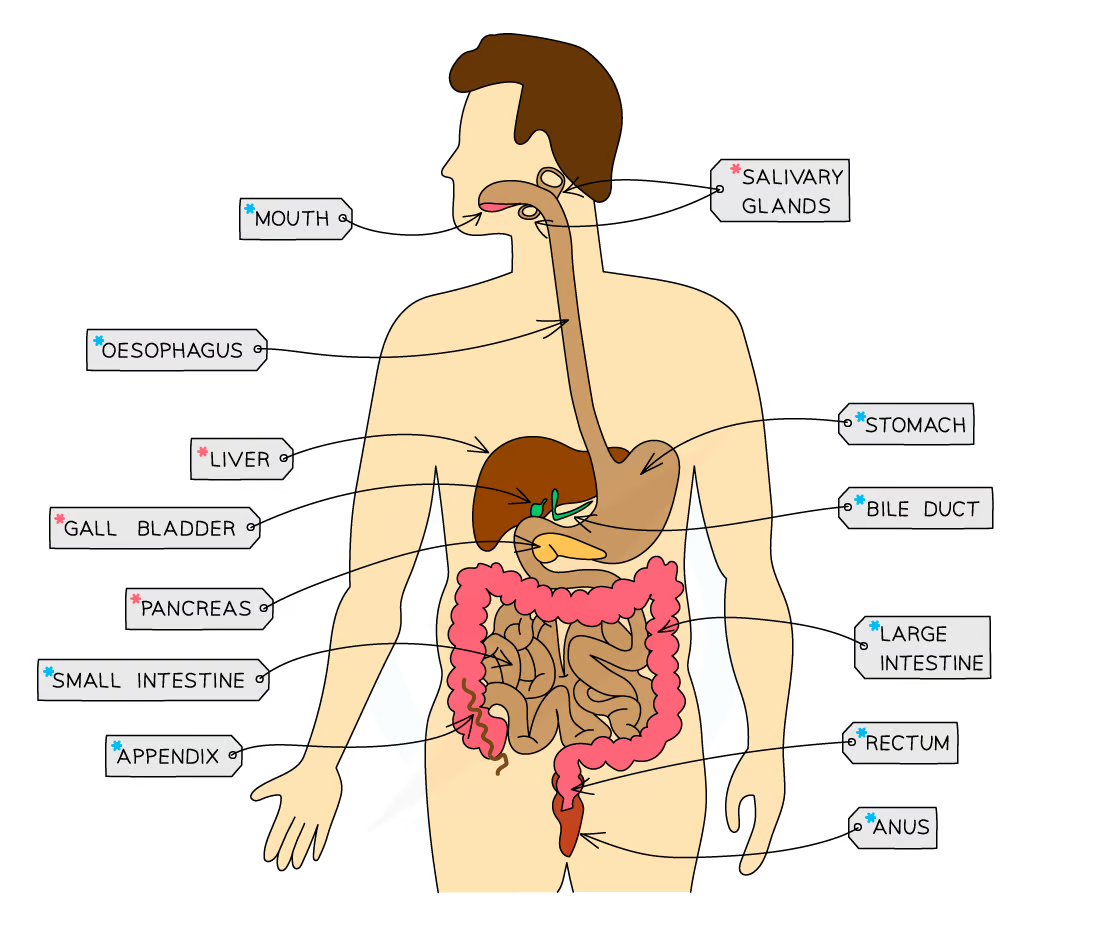
You need to be able to identify these in a diagram.
Functions of the digestive system
Mouth:
Mechanical digestion takes place
Teeth chew food to increase its surface area to volume ratio
Amylase enzymes in saliva digest starch into maltose
The tongue shapes the food into a bolus (ball)
Oesophagus:
Tube that connects the mouth to the stomach
Wave-like contractions take place to push the food bolus down without relying on gravity
Stomach:
Mechanical digestion takes place
This is done by churning actions
Protease enzymes start to chemically digest proteins
Hydrochloric acid kills bacteria in food and provides optimum pH for protease enzymes
Small intestine:
Divided into two sections, the ileum and duodenum:
Food finishes being digested in the duodenum
17 - Inheritance
17.1 Chromosomes, genes and proteins
Chromosomes are of DNA, which contains genetic information in the form of genes.
A gene is a length of DNA that codes for a protein.
An allele is an alternative form of a gene.
The inheritance of sex is determined by an entire chromosome pair:
Males: XY
Females: XX
Only the father can pass on the Y chromosome, so sex is determined by the father.
Proteins and genes
The sequence of bases in a gene determines the sequence of amino acids used to make a specific protein.
Different sequences of these amino acids give different shapes to protein molecules.
DNA controls cell function by controlling the production of proteins, including enzymes, membrane carriers and receptors for neurotransmitters
Protein synthesis (how a protein is made):
The gene coding for the protein remains in the nucleus as it is too large to leave to the cytoplasm
mRNA molecules (a copy of the gene) are made in the nucleus and move into the cytoplasm
The mRNA attaches to a ribosome
The ribosome translates the sequence of bases in the mRNA into a sequence of amino acids
The sequence of bases determines the order of amino acids (which determines the protein produced)
Once the chain of amino acids has been assembled, it is released from the ribosome so it can form the final structure of a protein
Most body cells in an organism contain the same genes but many genes in a particular cell are not expressed because the cell only makes the specific proteins it needs.
A haploid nucleus is a nucleus containing a single set of chromosomes
A diploid nucleus is a nucleus containing two sets of chromosomes.
In a diploid cell, there is a pair of each type of chromosome. In human diploid cells, there are 23 pairs (46 total chromosomes).
17.2 Mitosis
Mitosis is nuclear division giving rise to genetically identical cells.
It is used in growth, repair of damaged tissues, replacement of cells and asexual reproduction.
Before mitosis, the exact replication of chromosomes occurs.
During mitosis, the copies of chromosomes separate, maintaining the chromosome number in each daughter cell
Stem cells are specialized cells that divide by mitosis to produce daughter cells that can become specialized for certain functions
17.3 Meiosis
Meiosis is a reduction division in which the chromosome number is halved from diploid to haploid resulting in genetically different cells.
It is involved in the production of gametes.
17.4 Monohybrid inheritance
Inheritance is the transmission of genetic information from generation to generation.
Genotype is the genetic make-up of an organism in terms of the alleles present.
Phenotype is the observable features of an organism.
Homozygous is having two identical alleles of a particular gene.
Two identical homozygous individuals that breed together will be pure-breeding.
Heterozygous is having two different alleles of a particular gene.
A heterozygous individual will not be pure-breeding.
A dominant allele is an allele that is expressed if it is present in the genotype.
A recessive allele is an allele that is only expressed when there is no dominant allele of the gene present in the genotype.
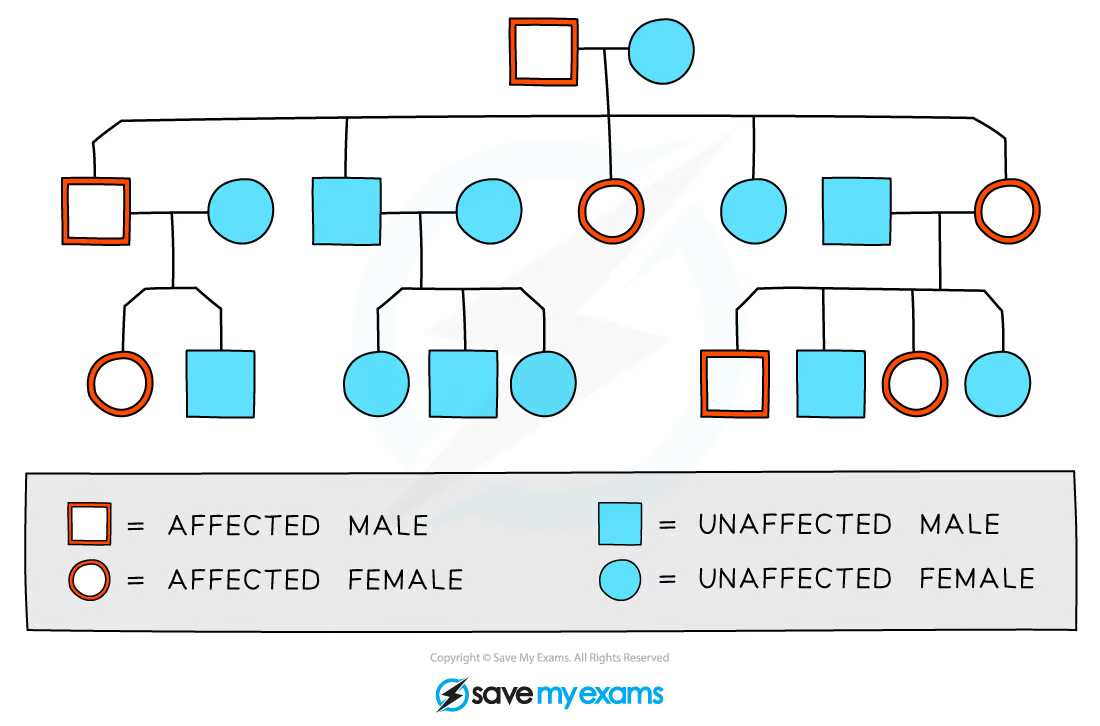
This is a pedigree diagram. You must be able to interpret it for the inheritance of a given characteristic.
How to construct a Punnett square
Determine the parental genotypes
Select a character with a clearly different lowercase (e.g. Aa, Tt, Bb)
Capital letters represent dominant alleles, lowercase letters represent recessive alleles.
Split the alleles for each parent and add them to the Punnett square around the outside
Fill in the four middle squares of the Punnett square to work out possible genetic combinations in the offspring.
1:1 ratio Punnett square example:
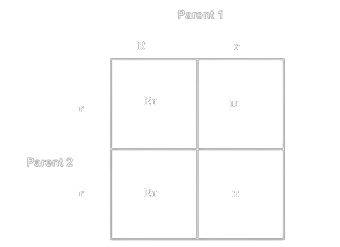 Assume R represents black hair and r represents blond hair:
Assume R represents black hair and r represents blond hair:
This Punnett square shows a 1:1 ratio. There is an equal chance for the offspring to have black hair (heterozygous) as there is a chance for the offspring to have blond hair (homozygous recessive).
There is a 50% chance that the offspring will have black hair, with the blond hair allele just not expressed
There is also a 50% chance that the offspring will have blond hair, passing on the gene to their offspring.
3:1 ratio Punnett square example:
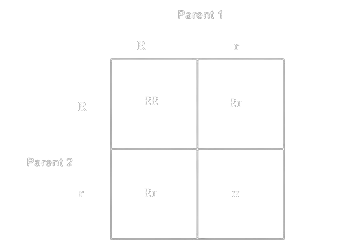 Assume R represents black hair and r represents blond hair:
Assume R represents black hair and r represents blond hair:
This Punnett square shows a 3:1 ratio.
There is a 75% chance for the offspring to have black hair, with the blond hair allele just not expressed.
There is also a 25% chance for the offspring to have blond hair, passing on the gene to their offspring.
Test cross (Identifying an unknown genotype):
Breeders can use a test cross to find out the genotype of an organism showing the dominant phenotype
This involves crossing the unknown individual with an individual showing the recessive phenotype - if the individual is showing the recessive phenotype, then its genotype must be homozygous recessive
By looking at the ratio of phenotypes in the offspring, we can tell whether the unknown individual is homozygous dominant or heterozygous.
Codominance is a situation in which both alleles in a heterozygous organism contribute to the phenotype.
A case of codominance is blood groups:
Alleles IA and IB are codominant, but both are dominant to IO
Blood group A can either have the genotype IAIA or IAIO
Blood group B can either have the genotype IBIB or IBIO
Blood group AB has the genotype IAIB
Blood group O has the genotype IOIO
A sex-linked characteristic is a feature in which the gene responsible is located on a sex chromosome and this makes the characteristic more common in one sex than the other.
An example is red-green colorblindness.
The gene for it is recessive and almost always found on the X chromosome.
Males only have one X chromosome so if they inherit this gene they will express red-green colorblindness
Females have two X chromosomes so it is much rare for them to get red-green colorblindness as the dominant chromosome for normal vision will express instead
You must be able to use genetic diagrams to predict the results of monohybrid crosses involving codominance or sex linkage and calculate phenotypic ratios.
18 - Variation and selection
18.1 Variation
Variation describes differences between individuals of the same species.
Continuous variation results in a range of phenotypes between two extremes, like height or body mass. It can be a value like 130cm, 150kg etc.
It is caused by both genes and the environment.
Here is an example of a chart for continuous variation, you should know how to investigate using it and describe it.
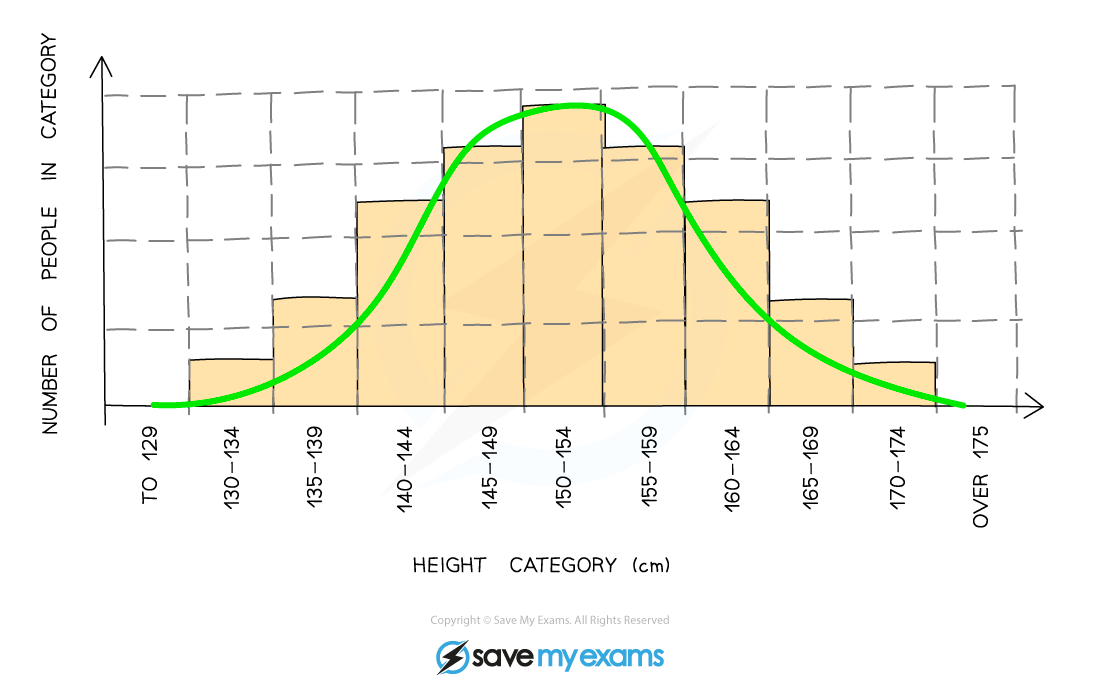
Discontinuous variation results in a limited number of phenotypes with no intermediates, such as ABO blood groups
It is usually caused by genes only.
Here is an example of a chart for discontinuous variation, you should know how to investigate using it and describe it.
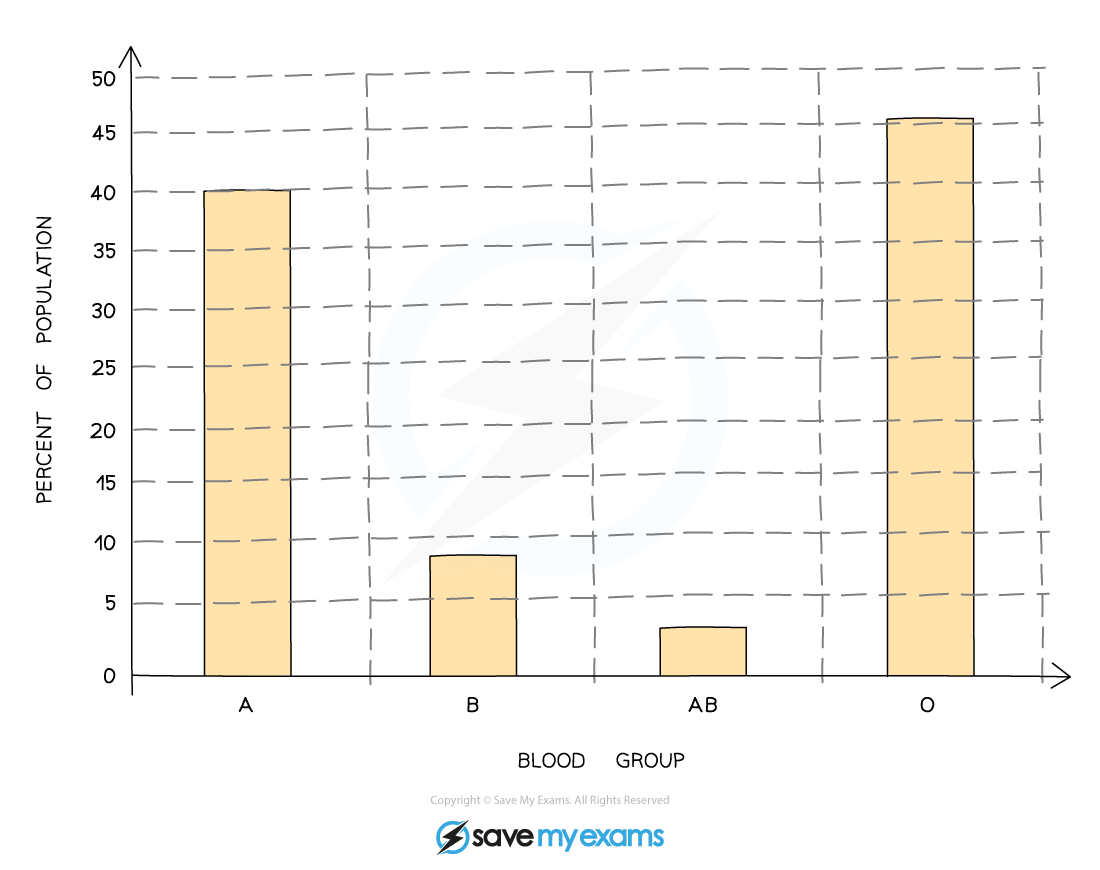
Mutation is genetic change.
Gene mutation is a random change in the base sequence of DNA.
Mutation is the way in which new alleles are formed.
Mutation, meiosis, random mating and random fertilization are all sources of genetic variation in populations.
Ionizing radiation and some chemicals increase the rate of mutation.
18.2 Adaptive features
An adaptive feature is an inherited feature that helps an organism to survive and reproduce in its environment.
You must be able to interpret images or other information about a species to describe its adaptive features.
Hydrophytes are plants adapted to live in extremely wet conditions
Large air spaces in their leaves for flotation, to keep the leaves close to the surface of the water where there is more light for photosynthesis
Small roots as they can also extract nutrients from the surrounding water through their tissues
Stomata usually open all the time and mainly found on the upper epidermis of the leaf where they can exchange gases much more easily with the air
Xerophytes are plants adapted to live in extremely dry conditions
Thick waxy cuticle to prevent water loss
Stomata sunk in epidermis to lengthen diffusion pathway and reduce evaporation rate
Leaf rolled with stomata inside and inner surface covered in hairs to trap moist air and prevent air movement across stomata reducing transpiration
Small leaves to reduce surface area and evaporation surface
Extensive shallow roots to absorb as much water as it can when it rains
Thickened leaves to store more water
18.3 Selection
Natural selection refers to:
Members of a species show a range of variation based on different alleles and genes
When organisms reproduce, they often produce more offspring than the environment can support
So there is competition for food and a struggle for survival
There is a greater chance of reproduction by individuals that are better adapted to the environment
They pass down their alleles to future generations
An example of this process is the development of antibiotic resistance in bacteria
When exposed to an antibiotic, bacteria die, however the bacteria with antibiotic resistance survive and survive another generation
There is now less struggle for survival and there is a much larger population of these bacteria
Adaptation is the process, resulting from natural selection, by which species become more suited to their environment over generations.
Selective breeding refers to:
Individuals with desirable features being selected by humans
These individuals are crossed to produce the next generation
The offspring showing the desirable features are selected
You must be able to apply this to contexts such as how it has improved crop plants and domesticated animals.
NATURAL SELECTION | ARTIFICIAL SELECTION |
|---|---|
Occurs naturally | Only occurs when humans intervene |
Results in the development of populations with features that are better adapted to their environment and survival | Results in development of populations with features that are useful to humans and not to the survival of the individual |
Takes a longer time to occur | Takes less time as only the individuals with desired features are allowed to reproduce |
19 - Organisms and their environment
19.1 Energy flow
The Sun is the principal source of all energy input to biological systems.
Syllabized IGCSE Biology
🌷
before you read🌷core content is written like this
supplement content is written like this
non-syllabus content is written like this
stuff you shouldn’t write in your exam is written like this
words you have to define are written like this
credit to taleen
1 - Characteristics and classification of living organisms
1.1 Characteristics of living organisms
1 - Define the seven life processes, MRS GREN:
Movement - An action by an organism of part of an organism that causes a change in position or place
Respiration - The chemical reactions in cells that break down nutrient molecules and release energy for metabolism
Sensitivity - The ability to detect and respond to changes in the internal or external environment
Growth - A permanent increase in size and dry mass
Reproduction - The processes that make more of the same kind of organism
Excretion - The removal of the waste products of metabolism and substances in excess of requirements
Nutrition - The taking in of materials for energy, growth and development
1.2 Concept and uses of classification systems
Organisms can be classified into groups by the features that they share, with what we call a classification system.
Classification systems aim to reflect evolutionary relationships, showing the similarities in organisms as they evolved and grouping them into classes.
A species is a group of organisms that can reproduce to produce fertile offspring.
The binomial system is a system we use to name species. It is internationally agreed and consists of two parts, the genus and the species.
The genus comes first and has a capital first letter, while the species comes after and is in full lowercase. We also usually write it in italics. An example is Bombyx mori (“Bombyx” is the genus while “mori” is the species).
Scientists used to just classify organisms based on the features they share but this sometimes got problematic. We now more often use the sequences of bases in DNA as a means of classification.
Groups of organisms which share a more recent ancestor (are more closely related) have more similar base sequences in DNA.
This method of classification is the most efficient way of classifying organisms, with the others being morphology and anatomy.
Dichotomous keys
A dichotomous key classifies and identifies organisms with a sequence of questions about their features. Here’s an example of one.
1.3 Features of organisms
You must be able to classify organisms based on the characteristics you’re about to see (the ones in the tables).
There are five kingdoms:
Animals
Plants
Fungi
Protoctists
Prokaryotes
KINGDOM | Plants | Animals | Fungi | Protoctists | Prokaryotes |
CELL COUNT | Multicellular | Multicellular | Usually multicellular | Usually unicellular | Usually unicellular |
CELL FEATURES | - nuclei - chloroplasts - cell walls (which are made of cellulose) | - nuclei - no chloroplasts - no cell walls | - nuclei - no chloroplasts - cells walls (not made of cellulose) | - nuclei - some have cell walls - some have chloroplasts | - cell walls (not of cellulose) - cytoplasm - no nuclei - no mitochondria |
The animal kingdom
It has two groups:
Vertebrates, they have a backbone
Invertebrates, they have no backbone
Here are the main groups of vertebrates:
VERTEBRATE GROUP | Mammals | Birds | Reptiles | Amphibians | Fish |
FEATURES | Fur/hair on skin, have a placenta, young feed on milk from mammary glands, external ears (pinna) visible, endothermic | Skin covered in feathers, have 2 legs and 2 wings, lay eggs with hard shells on land, have a break, endothermic | Dry scales on skin, lay eggs with rubbery shells on land | Smooth, moist skin, adults usually live on land (have lungs), larvae live in water (have gills) lay eggs without shells in water | Loose wet scales on skin, gills to breathe, lay eggs without shells in water |
We classify invertebrates into the phylum Arthropods if they have jointed legs.
Here are the main groups of arthropods:
ARTHROPOD GROUP | Insects | Arachnids | Crustaceans | Myriapods |
FEATURES | 3 part body (head, thorax, abdomen), 3 pairs of jointed legs, 2 pairs of wings, 1 pair of antennae | 2 part body (cephalothorax, abdomen), 4 pairs of jointed legs, no antennae | More than 4 pairs of jointed legs, chalky exoskeleton, breath through gills, 2 pairs of antennae | Body consists of many segments, each segment contains at least 1 pair of jointed legs, 1 pair of antennae |
The plant kingdom
It has two main groups:
Ferns:
Have leaves called fronds
Reproduce by spores produced on the underside of fronds
Flowering plants:
Reproduce by sexual reproduction
Are divided into two groups - monocotyledons and dicotyledons
Monocotyledons | Dicotyledons |
Flower petals in multiples of 3 | Flower petals in multiples of 4 or 5 |
Parallel leaf veins | Branched/reticulated leaf veins |
Viruses
Viruses are not considered living things as they do not carry out the 7 life processes.
Their structure consists of genetic material (like DNA or RNA) inside a protein coat.
2 - Organization of the organism
2.1 Cell structure
The table below compares the features of animal cells, plant cells and bacterial cells:
Animal cell | Plant cell | Bacterial cell |
No cell wall | Cellulose cell wall | Cell wall not made of cellulose |
Have a cell membrane | Have a cell membrane | Have a cell membrane |
Have a nucleus | Have a nucleus | No nucleus |
Have a cytoplasm | Have a cytoplasm | Have a cytoplasm |
Have ribosomes | Have ribosomes | Have ribosomes |
Have mitochondria | Have mitochondria | No mitochondria |
No chloroplasts | Have chloroplasts | No chloroplasts |
No vacuoles | Have vacuoles | No vacuoles |
Non-circular DNA | Non-circular DNA | Circular DNA |
No plasmids | No plasmids | Have plasmids |
The diagrams shown below portray animal cells, plant cells and bacterial cells respectively:

 You must know how to describe the functions of the parts shown as well:
You must know how to describe the functions of the parts shown as well:
Cell membrane - holds the cell together, controls the substances which can enter and leave the cell
Nucleus - contains the genetic material which controls the activities of the cell
Cytoplasm - gel-like substance composed mostly of water, supporting the internal cell structures and is the site of the chemical reactions in the cell
Ribosome - the site of protein synthesis
Mitochondria (singular: mitochondrion) - site of aerobic respiration, releases energy. (yes, it is the powerhouse of the cell)
Cell wall - gives the cell extra support, defining its shape
Chloroplast - contains green chlorophyll pigments and it is the site of photosynthesis
Vacuole - stores cell sap, it’s made up of water, sugar and salts. It’s also used for storage of other materials, and supports the shape of the cell
Circular DNA - circular chromosome of DNA that replaces nucleus in bacterial cells
Plasmid - small circular loops of DNA that contain extra genes to those found in chromosomal DNA
New cells are produced by division of existing cells.
Specialized cells have specific functions, including:
Cell | Function |
|---|---|
Ciliated cells | Movement of mucus in the trachea and bronchi |
Root hair cells | Absorption |
Palisade mesophyll cells | Photosynthesis |
Neurons | Conduction of electrical impulses |
Red blood cells | Transport of oxygen |
Sperm and egg cells (gametes) | Reproduction |
Define the levels of organization in organisms:
Cells - basic structural and functional units in an organism
Tissues - groups of cells of similar structure working together to perform the same function
Organs - made from different tissues working together to perform different functions
Organ systems - groups of organs with related functions working together to perform body functions
Organism - a living thing.
In size, from smallest to largest:
cell → tissue → organ → organ system → organism
 2.2 Size of specimens
2.2 Size of specimens
Magnification (M) = image size (I) ÷ actual size (A)
We can use an equation triangle to remember this formula:
 We don’t use units for magnification, it is written as, for example, “x70”, “x100” or “x69”
We don’t use units for magnification, it is written as, for example, “x70”, “x100” or “x69”
If asked to measure a diagram, it will usually be in millimeters.
You must be able to convert between millimeters and micrometers.
1mm = 1000μm (micrometers)
So you multiply millimeter values by 1000 to get a micrometer value and you divide micrometer values by 1000 to get a millimeter value.
3 - Movement into and out of cells
3.1 Diffusion
Diffusion is the net movement of particles from a region of higher concentration to a region of lower concentration down the concentration gradient (as a result of their random movement).
Energy for diffusion comes from the kinetic energy of random movement of molecules and ions.
Some substances move into and out of cells by diffusion through the cell membrane.
Diffusion happens everywhere, including:
Organisms carrying out gas exchange for respiration
Water vapor diffusing out of a leaf’s stomata
Food diffusing through the walls of the small intestine through the villi
Factors influencing diffusion
surface area
the larger the surface area, the faster the rate of diffusion
this is due to there being more space for the particles to diffuse through a surface
distance
the smaller the distance, the faster the rate of diffusion
this is due to the particles not having to move as far to diffuse across the surface
concentration gradient
the steeper the concentration gradient, the faster the rate of diffusion
this is due to the molecules having more random collisions on the side with higher concentration
temperature
the higher the temperature, the faster the rate of diffusion
this is due to the molecules having more kinetic energy and therefore moving faster
3.2 Osmosis
Water is important as it is a solvent, and it has many essential uses:
Substances that are dissolved in water can be easily transported around the body
Digested food molecules are also moved to cells everywhere - without water this would not be possible
Wasteful and toxic substances can dissolve in water making them easy to excrete as urine
Osmosis is the net movement of water molecules from a region of higher water potential to a region of lower water potential, through a partially permeable membrane.
Water potential is the term we use to describe how much water there is per unit volume in a substance. It is the “water version” of concentration - we can’t actually use the word “concentration” for osmosis because concentration refers to how much solute there is in a substance while water is a solvent.
Cells are surrounded by a cell membrane which is partially permeable (only allows some substances in).
Water diffuses through this partially permeable membrane by osmosis.
so, water moves into and out of cells through this partially permeable membrane by osmosis.
Investigating osmosis with dialysis tubing
Dialysis tubing (or Visking tubing) is a non-living partially permeable membrane. Its pores are small enough to let water molecules in/out (by diffusion/osmosis) but not larger molecules.
To investigate osmosis with dialysis tubing:
Fill a section of dialysis tubing with concentrated sucrose solution
Suspending the tubing in a boiling tube of water for a set period of time
Observing whether the water level outside the tubing decreases
This is due to water being expected to diffuse into the tubing via osmosis as water moves from a region of high water potential (outside the tubing) to a region of low water potential (inside the tubing)
Immersing plant cells in solutions of different concentrations
Cut cylinders of root vegetables (e.g. a potato)
Weigh the cylinders
Place a cylinder into a boiling tube of distilled water and another cylinder in a boiling tube of concentrated sucrose solution, then wait 20-30 minutes
Remove the cylinders from their tubes
Dry the cylinders to remove excess weight and reweigh them
If the cylinder gained mass:
Water moved into the cylinder from the solution outside
The solution outside the cylinder is more dilute than the cylinder
If the cylinder lost mass:
Water moved out of the cylinder to the solution outside
The solution outside the cylinder is more concentrated (less dilute) than the cylinder
If the cylinder had the same mass:
There was no net movement of water
The solution and the cylinder are equally concentrated
Remember, water is still moving into and out of the cylinder, there is just no net movement of water
The effect of osmosis on plant cells
When plant cells are placed in a dilute solution and water moves into the cell by osmosis, the water molecules fill the vacuole and push the cell membrane against the cell wall, which increases the turgor pressure making the cell turgid.
When plant cells are placed in a concentrated solution and water moves out of the cell by osmosis, the cell will become flaccid, and the cell may become plasmolyzed which is when the cell membrane pulls away from the cell
This negatively affects a cell’s ability to support itself.
The effect of osmosis on animal cells
Animal cells have no supporting cell wall and so the effects are much more severe.
If the cell is placed in a dilute solution and too much water moves into the cell by osmosis, there no cell wall to create turgor pressure so the cell membrane will expand until the cell bursts.
If the cell is placed in a concentrated solution there is no supporting cell wall so the cell will simply become shriveled up.
3.3 Active transport
Active transport is the movement of particles through a cell membrane from a region of lower concentration to a region of higher concentration, against a concentration gradient using energy from respiration.
It is a vital process and it is used in many ways including:
the uptake of glucose by epithelial cells in the villi of the small intestine and kidney tubules of the nephron
the uptake of ions from soil water by root hair cells in plants
Protein carriers are what move molecules or ions across a membrane during active transport.
4 - Biological molecules
4.1 Biological molecules
MOLECULE | CHEMICAL ELEMENTS |
|---|---|
Carbohydrate | Carbon, hydrogen, oxygen |
Protein | Carbon, hydrogen, oxygen, nitrogen, (sometimes sulfur) |
Lipid | Carbon, hydrogen, oxygen |
Large molecules are made from smaller molecules.
Starch, glycogen and cellulose are made from glucose. These are the carbohydrates
Proteins are made from amino acids
Lipids (fats and oils) are made from fatty acids and glycerol
Food tests
Test for starch:
Add iodine solution
Positive result: Color change to blue/black
Negative result: Color stays brown/orange
Test for reducing sugars (glucose):
Add Benedict’s solution
Positive result: Color change to brick red or orange
Negative result: Color stays blue
Test for proteins:
Add biuret solution
Positive result: Color change to purple
Negative result: Color stays blue
Test for vitamin C:
Add 1cm³ of DCPIP
Positive result: Color disappears (went colorless)
Negative result: Color stays blue
Test for lipids (milky emulsion test):
Add ethanol
Shake gently and slightly
Positive result: milky white emulsion forms
Negative result: remains colorless
Structure of a DNA molecule
Two strands are coiled together to form a double helix
Each stranded contains chemicals called bases (A, T, C and G)
Bonds between the pairs of bases hold the strands together
The bases always pair up in the same way
A pairs with T
C pairs with G
You can think of this like: the straight lines (A and T) are together and the curved lines (C and G) are together
5 - Enzymes
5.1 Enzymes
A catalyst is a substance that increases the rate of a chemical reaction without being changed by it.
Enzymes are proteins that are involved in all metabolic reactions and they function as biological catalysts.
They are necessary to all living organisms as they maintain reaction speeds of all metabolic reactions (all the reactions that keep an organism alive) at a rate that can sustain life. If it were any slower, we wouldn’t function the same.
How enzymes work
Enzymes have a complementary shape to their substrate, kind of like a lock and key. The substrate binds to the active site of the enzyme, forming an enzyme-substrate complex. The product(s) are then formed and released, as they no longer fit in the active site.
Effects on enzymes
In order to investigate the effects of temperature on amylase:
Heat starch solution to a set temperature
Add iodine to wells of a spotting tile
Add amylase to the starch solution and mix well
Every minute, add droplets of the starch solution to a new well of iodine solution
Continue step 4 until the iodine stops turning blue/black (this means there is no more starch in the solution as it has been broken down)
Record the time taken for the reaction to complete
Repeat the experiment at different temperatures
The quicker the reaction is completed, the faster that means the enzymes are working
The higher the temperature, the quicker the reaction is completed.
This is because increasing the temperature also increases kinetic energy, meaning they’ll move faster and have more collisions with substrates
Enzymes have optimum temperatures (37°C in the human body), meaning that temperature is the temperature they’d work best in
Having the temperature too high would cause the enzyme to denature, meaning the active site would unfold and would no longer be able to fit substrates
Denaturation is irreversible
Having the temperature too low would just make the enzyme work very slowly
In order to investigate the effects of pH on amylase:
Place single drops of iodine solution in rows on the tile.
Label a test tube with the pH to be tested.
Use a syringe to place 2cm³
Add 1cm³ of buffer solution to the test tube using a syringe
Add 2cm³ of starch solution and start a stopwatch whilst mixing with a pipette
Every 10 seconds, use a pipette to place on drop of mixture on the first drop of iodine, which should turn blue-black
Record the time taken for the reaction to complete
Repeat the experiment at different pH levels
The quicker the reaction is completed, the faster the enzymes are working
The enzyme would work at its best when it’s at its optimum pH (for most enzymes it’s 7, but some work better at 2 or 8-9)
If the pH is too high or low, the bonds that hold the amino acid chains together to form the enzyme will be broken, therefore the enzyme will denature
6 - Plant nutrition
6.1 Photosynthesis
Photosynthesis is the process by which plants synthesize carbohydrates from raw materials using energy from light.
The word equation for photosynthesis is:
carbon dioxide + water → glucose + oxygen
The balanced chemical equation for photosynthesis is:
6CO2 + 6H2O → C6H12O6+ 6O2
Chlorophyll is a green pigment found in chloroplasts.
Chlorophyll transfers energy from light into energy in chemicals, for the synthesis of carbohydrates
Carbohydrates have many uses in plants:
Starch as an energy store
Cellulose to build cell walls
Glucose used in respiration to provide energy
Sucrose for transport in the phloem
Nectar to attract insects for pollination
Plants don’t eat so they need to make many substances themselves.
They need nitrogen and magnesium to make things like chlorophyll and amino acids.
MINERAL ION | FUNCTION | DEFICIENCY |
|---|---|---|
Magnesium | It is needed to make chlorophyll | Yellowing between veins of leaves |
Nitrate | Source of nitrogen to make amino acids | Stunted growth and yellowing of leaves |
Investigate the need for chlorophyll:
Boil a leaf in water to kill its cells
Leave it in a boiling tube with hot ethanol 5-10 minutes to remove the chlorophyll
Dip the leaf in boiling water to make it soft
Spread the leaf out on a white tile and cover it with iodine solution
The leaf turns blue/black if the leaf was green
If the leaf was partially green only the green parts turn blue/black
This means that only the areas with chlorophyll (green) photosynthesized so there was starch there. (That’s why it turned blue/black)
Investigate the need for light:
Before the experiment destarch the plant by placing it in a dark cupboard for 24 hours
Cover a part of the leaf with aluminum foil
Place the plant in sunlight for 24 hours
Test the leaf for starch with iodine
Areas exposed to sunlight will turn blue/black
Covered areas will remain orange/brown
This means that light is needed for photosynthesis as only the areas exposed to sunlight photosynthesized so they had starch present
Investigate the need for carbon dioxide:
Before the experiment destarch 2 plants by placing them in a dark cupboard for 24 hours
Place one of the leaves in a bell jar containing a beaker of sodium hydroxide which will absorb carbon dioxide from the surroundings.
Place the other plant in a bell jar that contains a beaker of water
Place both plants in a bright light for a set amount of hours.
Test the leaves in the plants for starch with iodine
The plant that was in water will have had its leaves turn blue/black
The plant that was in sodium hydroxide will remain orange/brown
This proves carbon dioxide is needed for photosynthesis
7 - Human nutrition
7.1 Diet
A balanced diet is a diet consisting of all of the food groups in the correct proportions.
The principal dietary sources are:
Carbohydrates - source/store of energy
Protein - growth and repair
Vitamins:
vitamin C - forms a part of the collagen protein which makes up skin, hair, gums and bones. A severe deficiency causes scurvy
vitamin D - helps the body absorb calcium so improves bone and teeth strength. A severe deficiency causes rickets
Mineral ions:
calcium - needed for strong teeth and bones and involved in the clotting of blood
iron - needed to make haemoglobin, which transports oxygen in red blood cells
Fibre - provides bulk (roughage) for the intestine to push food through it so helps food flow down the alimentary canal
Water - needed for chemical reactions to take place in cells
7.2 Digestive system

You need to be able to identify these in a diagram.
Functions of the digestive system
Mouth:
Mechanical digestion takes place
Teeth chew food to increase its surface area to volume ratio
Amylase enzymes in saliva digest starch into maltose
The tongue shapes the food into a bolus (ball)
Oesophagus:
Tube that connects the mouth to the stomach
Wave-like contractions take place to push the food bolus down without relying on gravity
Stomach:
Mechanical digestion takes place
This is done by churning actions
Protease enzymes start to chemically digest proteins
Hydrochloric acid kills bacteria in food and provides optimum pH for protease enzymes
Small intestine:
Divided into two sections, the ileum and duodenum:
Food finishes being digested in the duodenum
17 - Inheritance
17.1 Chromosomes, genes and proteins
Chromosomes are of DNA, which contains genetic information in the form of genes.
A gene is a length of DNA that codes for a protein.
An allele is an alternative form of a gene.
The inheritance of sex is determined by an entire chromosome pair:
Males: XY
Females: XX
Only the father can pass on the Y chromosome, so sex is determined by the father.
Proteins and genes
The sequence of bases in a gene determines the sequence of amino acids used to make a specific protein.
Different sequences of these amino acids give different shapes to protein molecules.
DNA controls cell function by controlling the production of proteins, including enzymes, membrane carriers and receptors for neurotransmitters
Protein synthesis (how a protein is made):
The gene coding for the protein remains in the nucleus as it is too large to leave to the cytoplasm
mRNA molecules (a copy of the gene) are made in the nucleus and move into the cytoplasm
The mRNA attaches to a ribosome
The ribosome translates the sequence of bases in the mRNA into a sequence of amino acids
The sequence of bases determines the order of amino acids (which determines the protein produced)
Once the chain of amino acids has been assembled, it is released from the ribosome so it can form the final structure of a protein
Most body cells in an organism contain the same genes but many genes in a particular cell are not expressed because the cell only makes the specific proteins it needs.
A haploid nucleus is a nucleus containing a single set of chromosomes
A diploid nucleus is a nucleus containing two sets of chromosomes.
In a diploid cell, there is a pair of each type of chromosome. In human diploid cells, there are 23 pairs (46 total chromosomes).
17.2 Mitosis
Mitosis is nuclear division giving rise to genetically identical cells.
It is used in growth, repair of damaged tissues, replacement of cells and asexual reproduction.
Before mitosis, the exact replication of chromosomes occurs.
During mitosis, the copies of chromosomes separate, maintaining the chromosome number in each daughter cell
Stem cells are specialized cells that divide by mitosis to produce daughter cells that can become specialized for certain functions
17.3 Meiosis
Meiosis is a reduction division in which the chromosome number is halved from diploid to haploid resulting in genetically different cells.
It is involved in the production of gametes.
17.4 Monohybrid inheritance
Inheritance is the transmission of genetic information from generation to generation.
Genotype is the genetic make-up of an organism in terms of the alleles present.
Phenotype is the observable features of an organism.
Homozygous is having two identical alleles of a particular gene.
Two identical homozygous individuals that breed together will be pure-breeding.
Heterozygous is having two different alleles of a particular gene.
A heterozygous individual will not be pure-breeding.
A dominant allele is an allele that is expressed if it is present in the genotype.
A recessive allele is an allele that is only expressed when there is no dominant allele of the gene present in the genotype.

This is a pedigree diagram. You must be able to interpret it for the inheritance of a given characteristic.
How to construct a Punnett square
Determine the parental genotypes
Select a character with a clearly different lowercase (e.g. Aa, Tt, Bb)
Capital letters represent dominant alleles, lowercase letters represent recessive alleles.
Split the alleles for each parent and add them to the Punnett square around the outside
Fill in the four middle squares of the Punnett square to work out possible genetic combinations in the offspring.
1:1 ratio Punnett square example:
 Assume R represents black hair and r represents blond hair:
Assume R represents black hair and r represents blond hair:
This Punnett square shows a 1:1 ratio. There is an equal chance for the offspring to have black hair (heterozygous) as there is a chance for the offspring to have blond hair (homozygous recessive).
There is a 50% chance that the offspring will have black hair, with the blond hair allele just not expressed
There is also a 50% chance that the offspring will have blond hair, passing on the gene to their offspring.
3:1 ratio Punnett square example:
 Assume R represents black hair and r represents blond hair:
Assume R represents black hair and r represents blond hair:
This Punnett square shows a 3:1 ratio.
There is a 75% chance for the offspring to have black hair, with the blond hair allele just not expressed.
There is also a 25% chance for the offspring to have blond hair, passing on the gene to their offspring.
Test cross (Identifying an unknown genotype):
Breeders can use a test cross to find out the genotype of an organism showing the dominant phenotype
This involves crossing the unknown individual with an individual showing the recessive phenotype - if the individual is showing the recessive phenotype, then its genotype must be homozygous recessive
By looking at the ratio of phenotypes in the offspring, we can tell whether the unknown individual is homozygous dominant or heterozygous.
Codominance is a situation in which both alleles in a heterozygous organism contribute to the phenotype.
A case of codominance is blood groups:
Alleles IA and IB are codominant, but both are dominant to IO
Blood group A can either have the genotype IAIA or IAIO
Blood group B can either have the genotype IBIB or IBIO
Blood group AB has the genotype IAIB
Blood group O has the genotype IOIO
A sex-linked characteristic is a feature in which the gene responsible is located on a sex chromosome and this makes the characteristic more common in one sex than the other.
An example is red-green colorblindness.
The gene for it is recessive and almost always found on the X chromosome.
Males only have one X chromosome so if they inherit this gene they will express red-green colorblindness
Females have two X chromosomes so it is much rare for them to get red-green colorblindness as the dominant chromosome for normal vision will express instead
You must be able to use genetic diagrams to predict the results of monohybrid crosses involving codominance or sex linkage and calculate phenotypic ratios.
18 - Variation and selection
18.1 Variation
Variation describes differences between individuals of the same species.
Continuous variation results in a range of phenotypes between two extremes, like height or body mass. It can be a value like 130cm, 150kg etc.
It is caused by both genes and the environment.
Here is an example of a chart for continuous variation, you should know how to investigate using it and describe it.

Discontinuous variation results in a limited number of phenotypes with no intermediates, such as ABO blood groups
It is usually caused by genes only.
Here is an example of a chart for discontinuous variation, you should know how to investigate using it and describe it.

Mutation is genetic change.
Gene mutation is a random change in the base sequence of DNA.
Mutation is the way in which new alleles are formed.
Mutation, meiosis, random mating and random fertilization are all sources of genetic variation in populations.
Ionizing radiation and some chemicals increase the rate of mutation.
18.2 Adaptive features
An adaptive feature is an inherited feature that helps an organism to survive and reproduce in its environment.
You must be able to interpret images or other information about a species to describe its adaptive features.
Hydrophytes are plants adapted to live in extremely wet conditions
Large air spaces in their leaves for flotation, to keep the leaves close to the surface of the water where there is more light for photosynthesis
Small roots as they can also extract nutrients from the surrounding water through their tissues
Stomata usually open all the time and mainly found on the upper epidermis of the leaf where they can exchange gases much more easily with the air
Xerophytes are plants adapted to live in extremely dry conditions
Thick waxy cuticle to prevent water loss
Stomata sunk in epidermis to lengthen diffusion pathway and reduce evaporation rate
Leaf rolled with stomata inside and inner surface covered in hairs to trap moist air and prevent air movement across stomata reducing transpiration
Small leaves to reduce surface area and evaporation surface
Extensive shallow roots to absorb as much water as it can when it rains
Thickened leaves to store more water
18.3 Selection
Natural selection refers to:
Members of a species show a range of variation based on different alleles and genes
When organisms reproduce, they often produce more offspring than the environment can support
So there is competition for food and a struggle for survival
There is a greater chance of reproduction by individuals that are better adapted to the environment
They pass down their alleles to future generations
An example of this process is the development of antibiotic resistance in bacteria
When exposed to an antibiotic, bacteria die, however the bacteria with antibiotic resistance survive and survive another generation
There is now less struggle for survival and there is a much larger population of these bacteria
Adaptation is the process, resulting from natural selection, by which species become more suited to their environment over generations.
Selective breeding refers to:
Individuals with desirable features being selected by humans
These individuals are crossed to produce the next generation
The offspring showing the desirable features are selected
You must be able to apply this to contexts such as how it has improved crop plants and domesticated animals.
NATURAL SELECTION | ARTIFICIAL SELECTION |
|---|---|
Occurs naturally | Only occurs when humans intervene |
Results in the development of populations with features that are better adapted to their environment and survival | Results in development of populations with features that are useful to humans and not to the survival of the individual |
Takes a longer time to occur | Takes less time as only the individuals with desired features are allowed to reproduce |
19 - Organisms and their environment
19.1 Energy flow
The Sun is the principal source of all energy input to biological systems.
 Knowt
Knowt